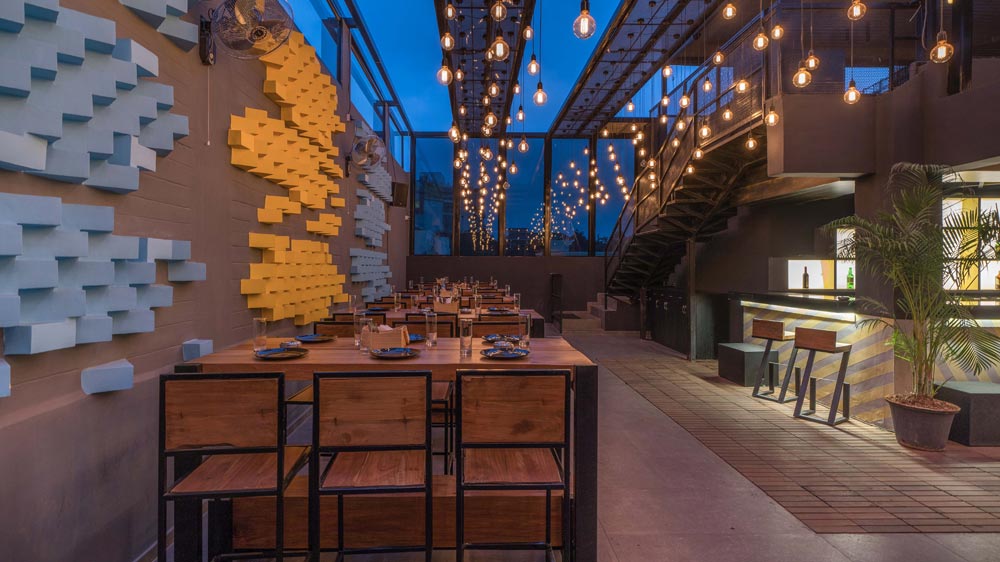
Traditionally, restaurants were simple places providing tables for eating and aimed at serving delectable food. With social and economic mindsets moving beyond home cooked meals, the restaurant business started to flourish. Ultimately, this leads to eating out becoming a way of life and ending up a ubiquitous and essential part of our thriving eco-space.
Theme and Ambiance
As society evolved and adapted, the world got smaller. People travelled wider and further ensuring far greater exposure to diverse cultures and cuisines. Along with wanting good food at a restaurant, people started demanding a good experience too. Along came the concept of themed restaurants, where the design could narrate to users both the essence of space and the value of it. To ensure they get the vibe and ambiance of a space right, architects and designers work with an intensive list of requests from clients keeping the target market in mind – the seating space, circulation area, design scheme, colour scheme, furniture, acoustics, lighting elements are all but a part of the whole that goes into ensuring the optimum utilization of space to achieve a desired theme. Every detail, no matter how minor or major, contributes to the vibe of a space. Whether it’s the colour scheme or the materials used or even just the design of the doorknob. Designers use furniture, tiles, lighting and all the myriad other minutiae that go into creating a unique design to establish and maintain the scale and balance of a space while ensuring its users connect to and feel the intimacy and mood immediately.
Comfort and Functionality
It is important to tread the line between comfort and functionality while designing a space. An ample amount of seating space is to be provided in a restaurant to reach equitable profit margins without compromising on the utility and efficiency of the place. The layout planned should grant enough circulation space and elbow room to both, patrons as well as the staff of the eatery, to ensure an uninterrupted flow of service across the expanse.
Requisite thermal conditions and proper humidity control aid in infusing apt indoor environments, which is an integral parameter for imparting user comfort. Restaurants need efficient HVAC (heating ventilation and air conditioning) systems due to internal heat gains from primitive kitchen areas.
Lighting
Lighting elements play a key role in restaurant design. Decorative, safe, low-maintenance and energy efficient lights aid in regulating the aesthetic as well as utility value of the area. A general 150 sq.ft restaurant requires 25 watts of lighting but with sustainable lighting solutions upto 80% of energy can be saved. The types of lighting elements highlighting the current wave of restaurant interior trends embrace ambient, accent and mood lighting. While ambient lighting uses a minimum of 20 watts for normal functions, accent lighting utilises about 64 watts to highlight a particular area. The energy requirement for mood lighting may vary owing to its need to influence the experiential set-up.
Acoustic resemblance
A restaurant communicates through its acoustic arrangement just as much as its menu card. Depending upon the concept, a specific acoustic tone is awarded to every diner as silence is definitely not golden for most of them. If the spot is designed with the agenda of an actual conversation, it would have low-tempo music, whereas some resto-bars prefer live entertainment drawing patrons that have an affinity for music. Acoustic control measures are very important in restaurants promoting night-club culture, as reverberation (excessive reflection of sound) can cause immense harm to the users. With proper calculations, a sound decay is arrived at that aids in the selection of a proper acoustic material to be implemented. A minimum of 20 percent acoustical coverage of the total area, has to be applied for proper sound absorption. Therefore, material with sound absorbing qualities like fabric panelling, carpeted floors, soft furnishings and upholstered chairs are incorporated by the designers in their design style, to deliver a ‘sound’ composition.
Our modus operandi…
A Designer’s prime responsibility is to cater to both functionality and the outlining of a gorgeous, breath-taking space that diners flock to. The idea is to manage creating an unconventional setting with exuberance that marks its place in an ever-growing food industry. We, at Urban Zen, design and execute a vast spectrum of projects of varying scales and profiles. It’s mostly our intuition that leads to our dramatically different outlook with design and execution.
For instance in Flashblack, we have presented people with a ‘non-intimidating’ environment that portrays its inclusive ambiance through a warm colour palette and engaging graffiti. With a façade accomplished in pine wood, the structure announces the vibe of its interior from the inception itself. The artistic bar zones are differentiated from the relaxed lounge areas by its vibrant epoxy floor finish. With a back-lit display, the bar serves users with a tangy cocktail of experiences. A human graffiti sketched out on the wall gives the space an off-beat semblance; while the usage of wood and ambient lighting sprinkles the area with the requisite warmth.
Usage of mild steel frames and black tandoor flooring for the double height pockets, supplement the bar with a re-defined sense of modernism. The other part of the floor is divided into mellow lounges with dimmed yellow lighting to amplify the customer’s comfortable experience. Mirroring the grey tiled flooring in the soft furnishings, these spaces utilize profuse amounts of wood, evidently displayed as a part of the aesthetic pine wood frames and the instilled decor. However, the decorative pendant pattern of the ceiling, is what completes the charming layout. Serving the functional aspects of acoustic treatment, DGU glazing has been installed which also aids in creating the visceral ambiance.
Thus, irrespective of the genre of restaurant a designer endeavours to compose, it is imperative to decide on the dominant regulatory factors and deliver the aura and vibe accordingly, with precise focus on all facets.
Copyright © 2009 - 2024 Restaurant India.









